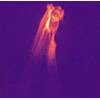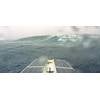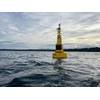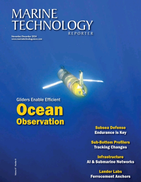Unmanned Surface Vessels: C-Stat Mobile Buoy USV System
Locked and Loaded for Hydrographic Missions
In recent years, the proliferation of unmanned surface vessels deployed for hydrographic missions has mushroomed as the collaborative effects of propulsion, software and sensor technologies has cumulatively made these vessels, large and small, more capable for a multitude of missions. In this edition, and on the heels of the Ocean Business exhibition last month in Southampton, Marine Technology Reporter examines recent developments.
ASV C-Stat Mobile Buoy USV System
The C-Stat from ASV offers a new capability in the dynamic positioning of equipment at sea for extended durations without the need of ships or seabed anchoring. The C-Stat uses a state-of-the-art autonomous controller and station keeping system integrated with the company’s C-Nav DGNSS system and a novel diesel-electric hybrid power system. The hull has been optimized for ocean performance and ease of launch and recovery.
The C-Stat embodies many of the advantages found in advanced unmanned systems, in that they can provide persistent, designed to collect and disseminate data at a fraction of the cost of manned operations. In the case of the C-Stat, it is designed for continuous operations, pending environment and mission, of between four and 30 days.
The mobile buoy type design of the C-Stat is designed to provide excellent stability in heavy seas, with the dual propulsion system for redundancy. Station keeping capability within less than 10m has been demonstrated, as well as deep ocean acoustic data transmission operations. Command and control via the ASView software system allows for both interactive piloting and preprogrammed activity during missions. Depending on configuration, the C-Stat Series of ASVs can maintain steerage at 0.5 to 5 knots.
The robust diesel-electric propulsion system is designed not only for redundancy and cost-efficient operation, but to carry a varied and heavier payload, vastly expanding its scope of operation.
Flexible payload options include echo sounders, acoustic modem/positioning, ADCPs, magnetometers, CDT, weather station, environmental sensors, passive acoustic monitoring and security related sensor systems, including video, camera and infrared systems.
C-Stat Specifications
Hull length 2.5m
Breadth 1.5m
Propulsion Diesel-electric
Duration 4-30 days, continuous
Surface Positioning C-Nav DGNSS
Comms UHF surface comms suitable for up to 7+ miles range
(As published in the May 2013 edition of Marine Technologies - www.seadiscovery.com)















 December 2024
December 2024



